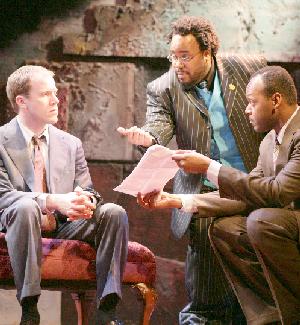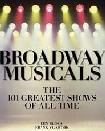SITE GUIDE
SEARCH
REVIEWS OF ALL CURRENTLY RUNNING NY SHOWS
FEATURES
Etcetera- NEWS
Broadway
Off-Broadway
BOOKS and CDs
OTHER PLACES
See links at top of our Main Page
QUOTES
TKTS
PLAYWRIGHTS' ALBUMS
LETTERS TO EDITOR
FILM
LINKS
MISCELLANEOUS
Free Updates
Masthead
Writing for Us
A CurtainUp Review
Widowers' Houses
By Elyse Sommer
|
If when you ask if you are as bad as I am, you mean that you are just as powerless to alter the state of our society, you are, unfortunately, quite right— Mr. Sartorius, to the young doctor who is shocked to discover that his income, like Sartorius's derives from the same social ill of slum housing.
|

(l-r) James Wallert, Jacob Ming-Trent and Godfrey L. Simmons, Jr. in Widowers' Houses. (Photo: Dixie Sheridan)
|
Widowers' Houses never achieved the popularity of Shaw's later and similarly themed Mrs. Warren's Profession. Its one and only run on Broadway in 1907 closed after just 16 performances so Shaw would undoubtedly have been pleased to see two contemporary companies retrieve it from the great attic where neglected plays end up.
Shaw would not have found any surprising changes in the Pearl Theater's 2005 traditional presentation. ( Widowers' Houses at the Pearl review), nor would he have been too surprised that the social ill of profiteering from rents collected from slum tenants is still with us. Consequently, there's a good chance that he would appreciate Ron Russell and Godfrey L. Simmons, Jr.'s concept for bringing Widowers' Houses into the twenty-first century. However, I'm not sure if he would approve of everything about Epic Theatre Center's production.
The adaptation remains true to the plot as devised by Shaw but has moved the action forward a hundred years and with a bi-racial cast in an American setting. The romance still begins during a holiday but it now takes place not in Germany but in South Carolina where Mr. Sartorious (Peter Jay Fernandez) started life in decidedly humble circumstances. The love birds' (James Wallert and Rachael Holmes) wedding plans still fall apart when Trench learns the source of his future father-in-law's fortune. As in the original script, the eventual reunion remains more ironic than idyllic. As Mr. Sartorius and his daughters are now African-Americans, so are Trench's impeccably dressed, status-conscious best buddy, William de Burgh Cokane (Godfrey L. Simmons, Jr.) is now an African-American as is Lickcheese (Jacob Ming-Trent), the Dickensian rent collector who turns crafty entrepreneur after being fired by Sartorius.
Having seen Widowers' Houses for the first time two years in its traditional permutation, and having also seen some fine work from Epic ( Einstein's Gift and Hannah and Martin), seeing this newfangled version was irresistible. It's an intelligent adaptation but a mixed bag, with a number of details that just don't jell within this time frame. In 1992, a rich man wanting to have his daughter accepted by everyone would send her to good schools and would be more likely to be visiting her in some Ivy League college than take her on a bildungsroman trip. The daughter might be spoiled and over-indulged with money and clothes, but unless she's a dumbell (which would hardly make a smart young doctor fall in love with her) she too would want to have some sort of career. As for Trent's income, he talks about the $30,000 a year interest from the family investments he must live on as a resident. But residents, while not paid a lot, do get at least that much, so the $30,000 Harry wants Blanche to make do with is more like a not too shabby $70,000. As for Harry's friend, dilletantes like Cokane were common at the time the play was written, but nowadays, and especially with Cokane portrayed as an upwardly mobile African-American, this adaptation begs for a little more of a backstory for this character.
Perhaps none of these plot points would matter if the actors were all up to the challenge of playing their part. James Wallert is fine as Harry Trent. Peter Jay Fernandez, warms up to his part in the second act. Jacob Ming-Trent is the most energetic performer on stage and quite amusingly seems to be channeling Al Sharpton. Godfrey L. Simmons Jr. is handsome but fails to rescue Cokane from being a cardboard figure. The most disappointing acting comes from the two female characters. Rachael Holmes brings neither charm or nuance to her role. The scene in which she physically abuses the parlor maid (Jessica Richardson) makes no sense at all and Richardson's in this role is all ham and without any satirical edge.
The cast does deserve credit for navigating the narrow and shallow stage and doing double duty as prop movers and director Ron Russell gamely compensates for limited exits by using the aisle. A hand too for set designer Cameron Anderson for managing to create three quite handsome sets.
The extensive use of pulsating rap music is covered in a lengthy program note. It explains that 1992 date was chosen for this adaptation partially because it was the year rap music began to claim a sizeable share of music and goes on to clarify some of the more politically oriented rap groups' aims and identify the buyers they most frequently reach. To further tap into the currency and educational mission of this adaptation, the lobby has a lot of background material on the current controversy surrounding the stallled sale of Starrett City, a low to middle income housing complex in Brooklyn A number of specialists in Urban studies are also scheduled to speak after various performances.
For more about Shaw's work and links to other Shaw plays reviewed, see our George Bernard Shaw Backgrounder.
| Widowers' Houses George Bernard Shaw's play, adapted by Ron Russell & Godfrey L. Simmons, Jr. Directed by Ron Russell Cast: Peter Jay Fernandez, James Wallert, Rachel Holmes, Jessica Richardson, Godfrey L. Simmons, Jr., Jacob Ming-Trent Sets: Cameron Anderson Costumes: Margaret L. Weedon Lights: Tyler Micoleau Sound: Ron Russell Running Time: 2 hours with one intermission Epic Theatre Center at Kirk Theatre, Theater Row, 212-279-4200 From 3/05/07 to 4/08/07; opening 3/14/07 Schedule varies Tickets: $40 Reviewed by Elyse Sommer at March 11th Matines |

Easy-on-the budget super gift for yourself and your musical loving friends. Tons of gorgeous pictures.

Leonard Maltin's 2007 Movie Guide

At This Theater
Leonard Maltin's 2005 Movie Guide

 >
>

